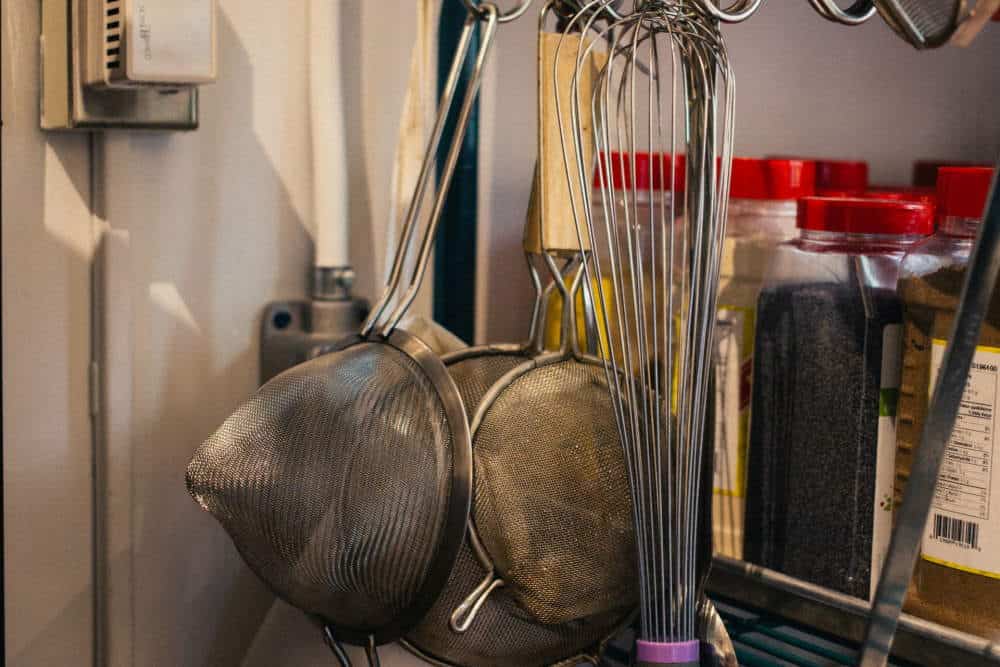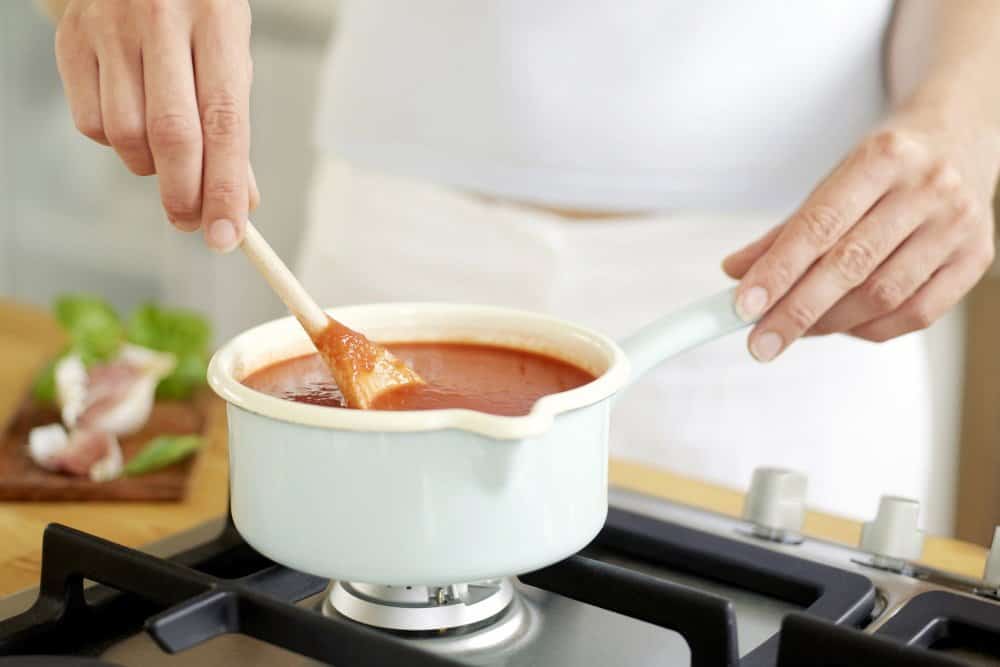If you’ve been looking into purchasing a food strainer and sauce maker, you probably realized just how many there are on the market, however, don’t be overwhelmed. These kitchen tools are straightforward to use.
Whether you are looking for a tomato sauce strainer for a salsa and taco night or an old-fashioned applesauce maker, you need to learn how to use one and familiarize yourself with how they work before deciding on which model you want.
So, with all this in mind, you’ll find our little info pack below to save you time when choosing your food strainer and sauce maker, let the straining talk begin!
How do you use a food strainer?
Food strainers can be used in various ways depending on what you want to make, the most common way to use a strainer would be to make a sauce.
Let’s go with the example of making applesauce, using a food strainer such as the Victorio brand can not only save time when making your sauce but also make the process much more enjoyable.
Step one
Cut up your favorite apples into quarters or halves depending on their size, crisp honey apples, or granny smith apples are some great choices if you want to avoid added sugar.
Step two
Cook your apples until soft. This will make sure they run through your strainer efficiently and give you smooth applesauce.
Step three
Put your softened apples into your strainer, and you should be left with smooth and delicious applesauce, this can be done in large batches and stored away in your kitchen cupboards.
So what is a fine mesh strainer?
A fine mesh strainer usually is referred to as a fine sieve. These sieves tend to be larger than tea strainers but smaller than our average-sized sieve.
Fine mesh strainers tend to be the perfect solution for taking out small particles in sauces, like a berry sauce, for example.
What is the difference between sieve and strainer?

Many people use the words sieve and strainer interchangeably, which can be kind of confusing, right?
Well, experts say that a sieve is a device to separate larger particles from smaller ones or solids from liquids, so think chicken broth or flour lumps here.
On the other hand, a strainer is where a liquid is passed through for purification from solids- so here think juices or even nut milk.
In a nutshell, strainers are meant for making those delicious recipes for applesauce or salsas with a tomato sauce strainer.
Which specifications should I be looking out for?
Now we know some more about strainers and how to use them, there are some pretty essential features you should consider before choosing your food strainer and sauce maker.
Automatic strainer or manual strainer?
If you are on a budget and are looking for a good arm workout, manual strainers would be a perfect choice for you.
Manual pros
- Suitable for one-off uses
- More satisfactory
- Typically cheaper in parts and selling price
Manual cons
- Gives a good arm workout (could be a pro if you want to gain some muscle)
- Takes longer straining time.
- Not suitable for larger batches.
However, if you are looking to do some quick work when it comes to making fresh purees, choose an automatic strainer. These devices are powered via an electric motor and save you a lot of time, especially if you plan to strain large batches.
Auto pros
- Quick and powerful
- The electric motor can be changed to different speeds
- Great for large batches
Auto cons
- Expensive parts
- Not as satisfactory
- Less control
The size
If you are looking to make large amounts of homemade products, consider looking for a food strainer that has a large container.
This is important as the larger it is, the more ingredients you can strain. Therefore you will be left with a more significant quantity.
Ease of cleaning
To make your life easier, make sure you choose a model that can be dismantled easily, such as the Victorio model, most parts can be rinsed easily, dried, and put back together.
How do you clean a mesh strainer?
Well, strainers are a pain to clean, but they can be easily washed if you let them soak in hot water after use.
The design
You should make sure your design has some essential parts, such as an improved handle, stainless steel screen, and a mounting clamp.
Accessory screens are great for foods like apples that have peels.
Warranty
Food strainers and sauce makers don’t come cheap, so make sure the model includes a whole year warranty to be confident with your purchase.
What are the different types of strainers?
If you have been doing your research, you’ve probably come across a fair few different strainers on the market.
There are strainers such as food mills, colanders, chinois, tamis, and more.
Let’s have a look below and compare their uses and features-
Food mill
Food mill models are a great tomato sauce maker machine and operate via a crank, which turns the metal blades of the device around a bowl where the food sits, underneath there is a sieve that strains out any solids as you puree your food.
Overall, food mill strainers are an excellent choice for making fresh purees or a tomato sauce strainer. They are also super easy to use.
Pros
- Easy to use and great for purees
- Blades can be switched
- Bowls can make large amounts
- Easy cleaning
Cons
- It can be significant and bulky
- It can also be pretty expensive
Colanders

Famous for draining pasta and canned ingredients, colanders have the added versatility of being used for numerous chores in your kitchen such as rinsing, washing and draining.
They used to be made with a sturdy aluminum cast body but now are available in plastic too.
By the way, did you know why you should never drain pasta in your sink?
Well, that cooking water is pretty impressive for thickening up sauces due to its starch content, so think twice before you chuck it down the drain, especially if you’re making a pasta sauce!
Pros
- Usually, have two handles, which are great for hot liquids
- It can be considerable for draining significant quantities
- Easy to use
Cons
- Not suitable for straining food
- Steel can rust
- It can be hard to clean
Chinois

You might be wondering what kind of cooking utensil a chinois is?
These strainers have a cone-like shape and a fine mesh strainer, which makes them perfect for sauces and soups, they can get rid of any lumps quickly and act as a great tomato sauce strainer too.
Pros
- Great for creating smooth sauces and fine powders
- Easy to use
- Often very durable
Cons
- Mesh strainer can make them expensive
- It can be challenging to clean
- Not suitable for making puree from scratch like a food mill
Potato/food ricer
Potato ricer strainers are great for mashing down potatoes into rice strands. They can also be used for taking out excess water in vegetables or puree avocado and soft fruits.
Pros
- Very durable and last a long time
- Help mash potatoes for smooth results
- It would be great for helping make purees out of boiled veg
Cons
- Don’t strain out any particles
- Only suitable for mashing
Tamis
Tamis often resemble a drum, they have a flat bottom and are used mainly for mashing and straining in the ingredients.
Pros
- Can mash and strain
- Not too expensive
Cons
- Less common
What’s the best food strainer and sauce maker?
With all the different strainers on the market, from electric sauce makers to manuals, you might be asking yourself what the best brands available are.
Some main competitors are the Victorio strainers, Squeezo strainers, and Roma strainers.
Victorio strainer
The Victoria food strainer and sauce maker are by far one of the most popular brands out there. For making apple or tomato sauce to pumpkin puree, these machines are known to be super reliable and easy to use.
Squeezo strainer
The Squeezo strainers are a trendy brand and are great for durability due to their aluminum body and long-lasting screens. These strainers can be used as an old fashioned applesauce maker and help with jams or other home food preservation.
Roma strainer
Roma manual food strainers help you “avoid peeling and coring” when making jams, baby food and purees, they have a bigger hopper and handle for user-friendly use.
These strainers also come with a Roman strainer screen pack for apple and tomato straining.
Recipe ideas with a food strainer and sauce maker
You can make many delicious recipes with a food strainer such as homemade jams or Mexican salsas, maybe even a spicy tomato paste.
Fresh puree
From pumpkin purees to raspberry purees, you can use strainers to make any veg or fruit puree you can think of. A garlic puree can be great for adding into sauces, too, especially curries.
Juices
You can use a food strainer in place of a juicer, how cool is that? You can blend your ingredients, then strain the smoothie for a pulp-free tasty juice.
Salsa
Who doesn’t love fresh salsa? Food strainers make salsa night so easy, all you need to do is choose your best tomato processor and add them with some of your favorite spices, then you’ve got your homemade salsa!
Sauces

Like puree, you can make tomato sauce, fruit sauce, and even more with your strainer.
A lot of people ask, how can you get the water out of tomato sauce?
The trick is to “add salt onto your tomatoes before straining,” this will draw out the excess water beforehand and leave you with a thick tomato sauce.
FAQs
Why should I buy a food strainer?
They are so useful to have in your kitchen and allow you to make your sauces with little efforts involved, such as peeling and coring.
What is the sieve number?
Sieve numbers can be a little complicated to understand, but they refer to how much material can pass through your sieve. For example, a number four sieves can allow nearly 90% of the material to pass through.
What is a bouillon strainer?
A bouillon strainer is a regular strainer with a beautiful mesh that can separate the seeds from liquids and sauces.
What kind of strainer is the best for baby food?
Potato ricers and chinois strainers are great for straining the puree for babies due to their fine mesh. Potato ricers, in particular, can help you make a quick puree in minutes.
How much should I spend on a food strainer?
This is a hard question to answer precisely because it depends on the strainer you buy, food mills can be anything from $15 to $200 depending on the kind you buy. Manual ones tend to be cheaper, so bear that in mind.
Are strainers complicated to use?
Not really, most food strainers are pretty easy to use, potato ricers may require more effort, and food mills often need more assembly too. As above, it depends on if you get a manual or automatic food mill in this case.
So should you buy a food strainer and sauce maker?
Overall, if you are looking for a cooking utensil that can upgrade your sauce making and save you time, a food strainer and sauce maker would be an excellent product for you to add to your kitchen.
Whether you choose a food mill, a chinois, or a colander, all these devices will help you achieve smooth purees and sauces.
The choice is yours, happy sauce making!
